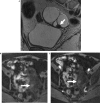MR imaging in ovarian cancer
- PMID: 17921097
- PMCID: PMC2727977
- DOI: 10.1102/1470-7330.2007.9046
MR imaging in ovarian cancer
Abstract
Magnetic resonance (MR) imaging is increasingly being used in patients with gynaecological disorders due to its high contrast resolution compared to computed tomography (CT) and ultrasound. In women presenting with an adnexal mass, ultrasound remains the primary imaging modality in the detection and characterisation of such lesions. However, in recent years overwhelming evidence has accumulated for the use of MR imaging in patients with indeterminate adnexal masses particularly in younger women and where disease markers are unhelpful. In staging ovarian cancer and for evaluating therapeutic response MR imaging is as accurate as CT but CT remains the imaging modality of choice because it is more widely available and quicker. This article reviews that evidence and outlines a place for the use of MR imaging in ovarian cancer.
Figures







Similar articles
-
MRI, CT, and PET/CT for ovarian cancer detection and adnexal lesion characterization.AJR Am J Roentgenol. 2010 Feb;194(2):311-21. doi: 10.2214/AJR.09.3522. AJR Am J Roentgenol. 2010. PMID: 20093590 Review.
-
Ovarian cancer: the clinical role of US, CT, and MRI.Eur Radiol. 2003 Dec;13 Suppl 4:L87-104. doi: 10.1007/s00330-003-1964-y. Eur Radiol. 2003. PMID: 15018172 Review.
-
Ovarian cancer: detection and radiologic staging.Clin Obstet Gynecol. 2009 Mar;52(1):73-93. doi: 10.1097/GRF.0b013e3181961625. Clin Obstet Gynecol. 2009. PMID: 19179862 Review.
-
ESR Essentials: characterisation and staging of adnexal masses with MRI and CT-practice recommendations by ESUR.Eur Radiol. 2024 Dec;34(12):7673-7689. doi: 10.1007/s00330-024-10817-1. Epub 2024 Jun 7. Eur Radiol. 2024. PMID: 38849662 Free PMC article. Review.
-
Imaging strategy for early ovarian cancer: characterization of adnexal masses with conventional and advanced imaging techniques.Radiographics. 2012 Oct;32(6):1751-73. doi: 10.1148/rg.326125520. Radiographics. 2012. PMID: 23065168 Review.
Cited by
-
Benign and Suspicious Ovarian Masses-MR Imaging Criteria for Characterization: Pictorial Review.J Oncol. 2012;2012:481806. doi: 10.1155/2012/481806. Epub 2012 Mar 22. J Oncol. 2012. PMID: 22536238 Free PMC article.
-
MR imaging of ovarian masses: classification and differential diagnosis.Insights Imaging. 2016 Feb;7(1):21-41. doi: 10.1007/s13244-015-0455-4. Epub 2015 Dec 16. Insights Imaging. 2016. PMID: 26671276 Free PMC article.
-
GyneScan: an improved online paradigm for screening of ovarian cancer via tissue characterization.Technol Cancer Res Treat. 2014 Dec;13(6):529-39. doi: 10.7785/tcrtexpress.2013.600273. Epub 2013 Dec 6. Technol Cancer Res Treat. 2014. PMID: 24325128 Free PMC article.
-
Ovarian Fibroma Presents As Uterine Leiomyoma in a 61-Year-Old Female: A Case Study.Cureus. 2023 Mar 16;15(3):e36264. doi: 10.7759/cureus.36264. eCollection 2023 Mar. Cureus. 2023. PMID: 37073210 Free PMC article.
-
A Case Report of Pseudomyxoma Peritonei Arising From Primary Mucinous Ovarian Neoplasms.Cureus. 2022 Sep 19;14(9):e29309. doi: 10.7759/cureus.29309. eCollection 2022 Sep. Cureus. 2022. PMID: 36277572 Free PMC article.
References
-
- Bammer R, Schoenberg SO. Current concepts and advances in clinical parallel magnetic resonance imaging. Top Magn Reson Imaging. 2004;15:129–58. - PubMed
-
- Forstner R, Hricak H, Occhipinti KA, Powell CB, Frankel SD, Stern JL. Ovarian cancer: staging with CT and MR imaging. Radiology. 1995;197:619–26. - PubMed
-
- Low RN, Sigeti JS., MR imaging of peritoneal disease. AJR. 1994;163:1131–40. - PubMed
-
- Ghossain MA, Buy JN, Ligneres C, et al. Epithelial tumors of the ovary: comparison of MR and CT findings. Radiology. 1991;181:863–70. - PubMed
-
- Thurnher S, Hodler J, Baer S, Marincek B, von Schulthess GK. Gadolinium-DOTA enhanced MR imaging of adnexal tumors. J Comput Assist Tomogr. 1990;14:939–49. - PubMed
Publication types
MeSH terms
Substances
LinkOut - more resources
Full Text Sources
Medical
